NISSAN FRONTIER 2018 Owner´s Manual
Manufacturer: NISSAN, Model Year: 2018, Model line: FRONTIER, Model: NISSAN FRONTIER 2018Pages: 502, PDF Size: 4.85 MB
Page 451 of 502
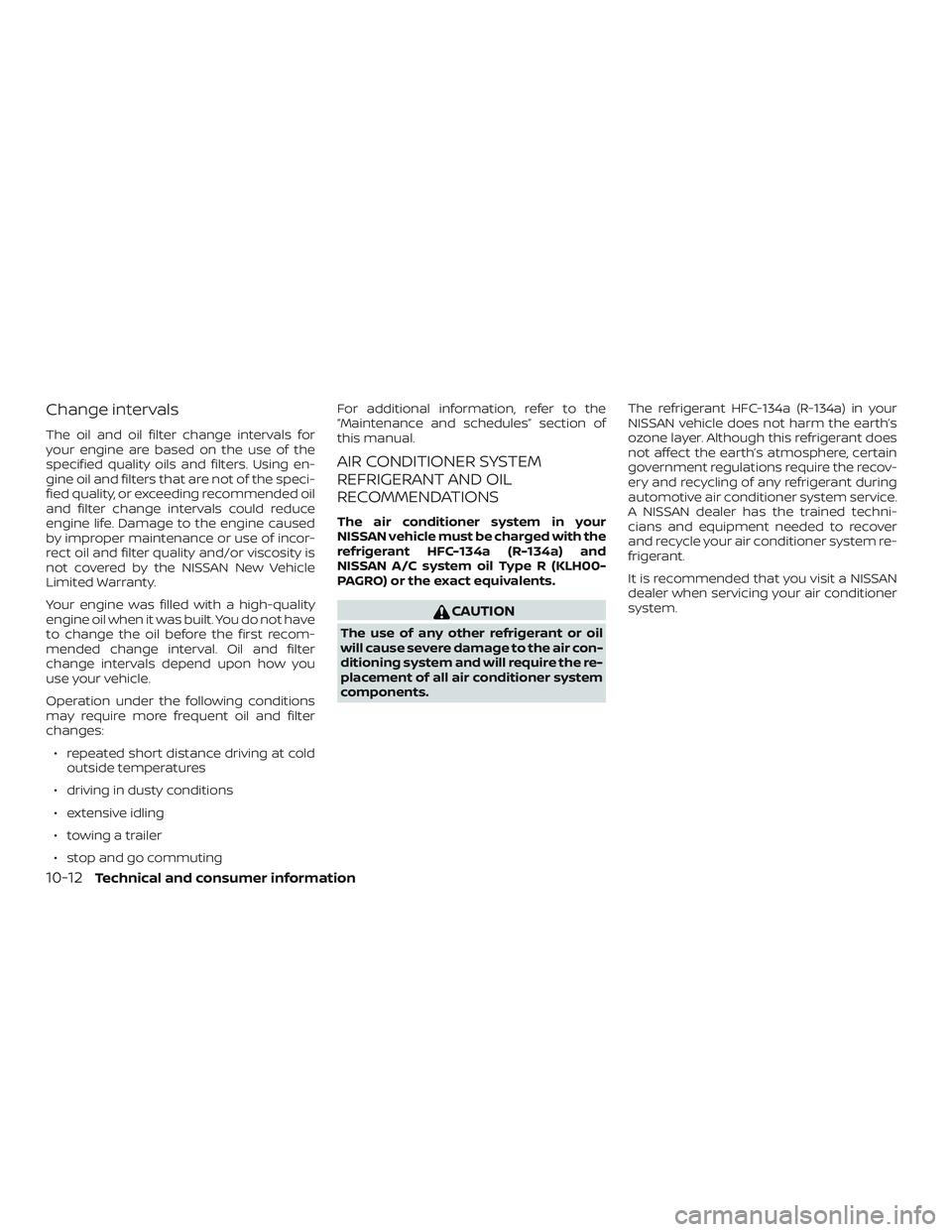
Change intervals
The oil and oil filter change intervals for
your engine are based on the use of the
specified quality oils and filters. Using en-
gine oil and filters that are not of the speci-
fied quality, or exceeding recommended oil
and filter change intervals could reduce
engine life. Damage to the engine caused
by improper maintenance or use of incor-
rect oil and filter quality and/or viscosity is
not covered by the NISSAN New Vehicle
Limited Warranty.
Your engine was filled with a high-quality
engine oil when it was built. You do not have
to change the oil before the first recom-
mended change interval. Oil and filter
change intervals depend upon how you
use your vehicle.
Operation under the following conditions
may require more frequent oil and filter
changes:∙ repeated short distance driving at cold outside temperatures
∙ driving in dusty conditions
∙ extensive idling
∙ towing a trailer
∙ stop and go commuting For additional information, refer to the
“Maintenance and schedules” section of
this manual.
AIR CONDITIONER SYSTEM
REFRIGERANT AND OIL
RECOMMENDATIONS
The air conditioner system in your
NISSAN vehicle must be charged with the
refrigerant HFC-134a (R-134a) and
NISSAN A/C system oil Type R (KLH00-
PAGRO) or the exact equivalents.
CAUTION
The use of any other refrigerant or oil
will cause severe damage to the air con-
ditioning system and will require the re-
placement of all air conditioner system
components.
The refrigerant HFC-134a (R-134a) in your
NISSAN vehicle does not harm the earth’s
ozone layer. Although this refrigerant does
not affect the earth’s atmosphere, certain
government regulations require the recov-
ery and recycling of any refrigerant during
automotive air conditioner system service.
A NISSAN dealer has the trained techni-
cians and equipment needed to recover
and recycle your air conditioner system re-
frigerant.
It is recommended that you visit a NISSAN
dealer when servicing your air conditioner
system.
10-12Technical and consumer information
Page 452 of 502
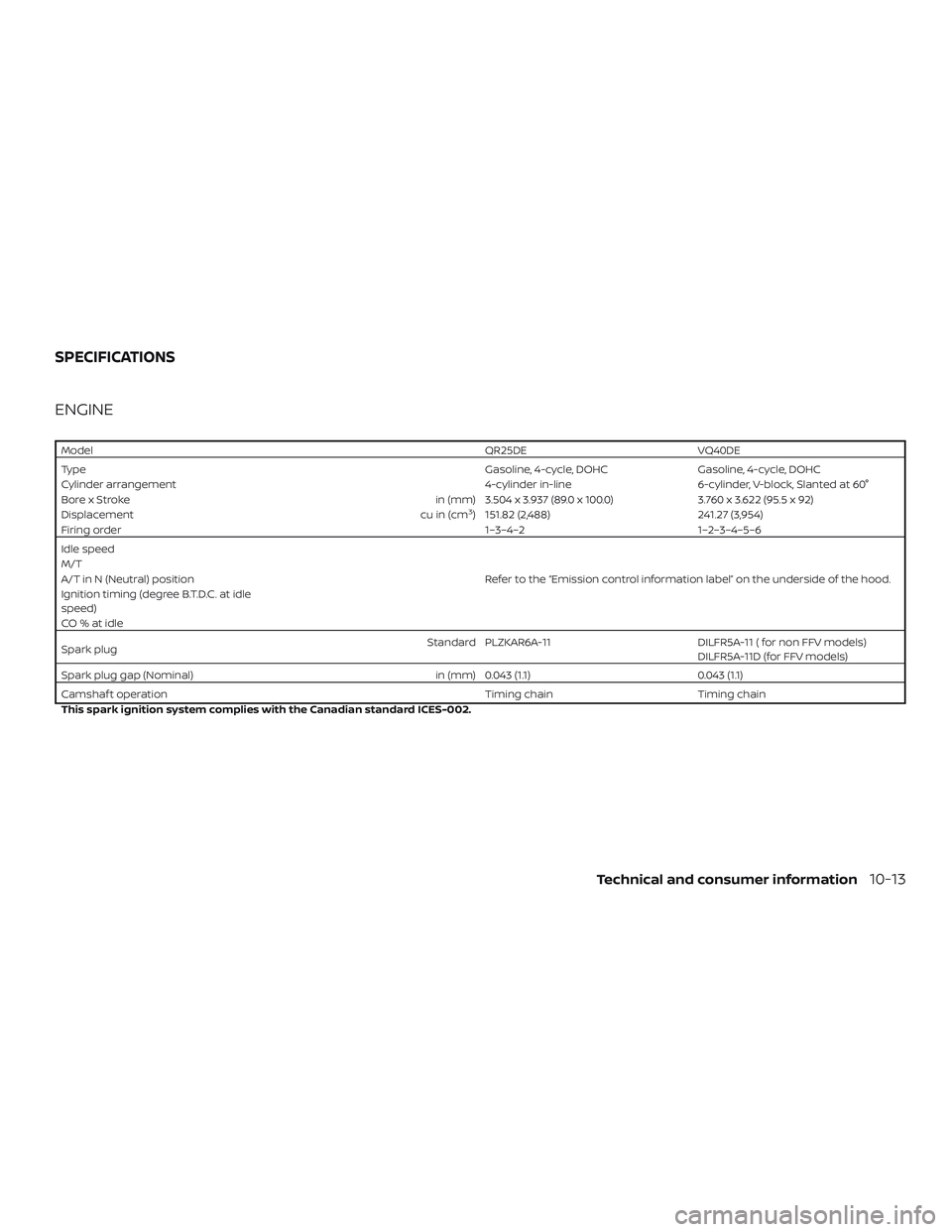
ENGINE
ModelQR25DE VQ40DE
Type Gasoline, 4-cycle, DOHCGasoline, 4-cycle, DOHC
Cylinder arrangement 4-cylinder in-line6-cylinder, V-block, Slanted at 60°
Bore x Stroke in (mm) 3.504 x 3.937 (89.0 x 100.0)3.760 x 3.622 (95.5 x 92)
Displacement cu in (cm
3) 151.82 (2,488)241.27 (3,954)
Firing order 1–3–4–21–2–3–4–5–6
Idle speed
M/T
A/T in N (Neutral) position Refer to the “Emission control information label” on the underside of the hood.
Ignition timing (degree B.T.D.C. at idle
speed)
CO%atidle
Spark plug Standard PLZKAR6A-11
DILFR5A-11 ( for non FFV models)
DILFR5A-11D (for FFV models)
Spark plug gap (Nominal) in (mm) 0.043 (1.1)0.043 (1.1)
Camshaf t operation Timing chainTiming chain
This spark ignition system complies with the Canadian standard ICES-002.
SPECIFICATIONS
Technical and consumer information10-13
Page 453 of 502
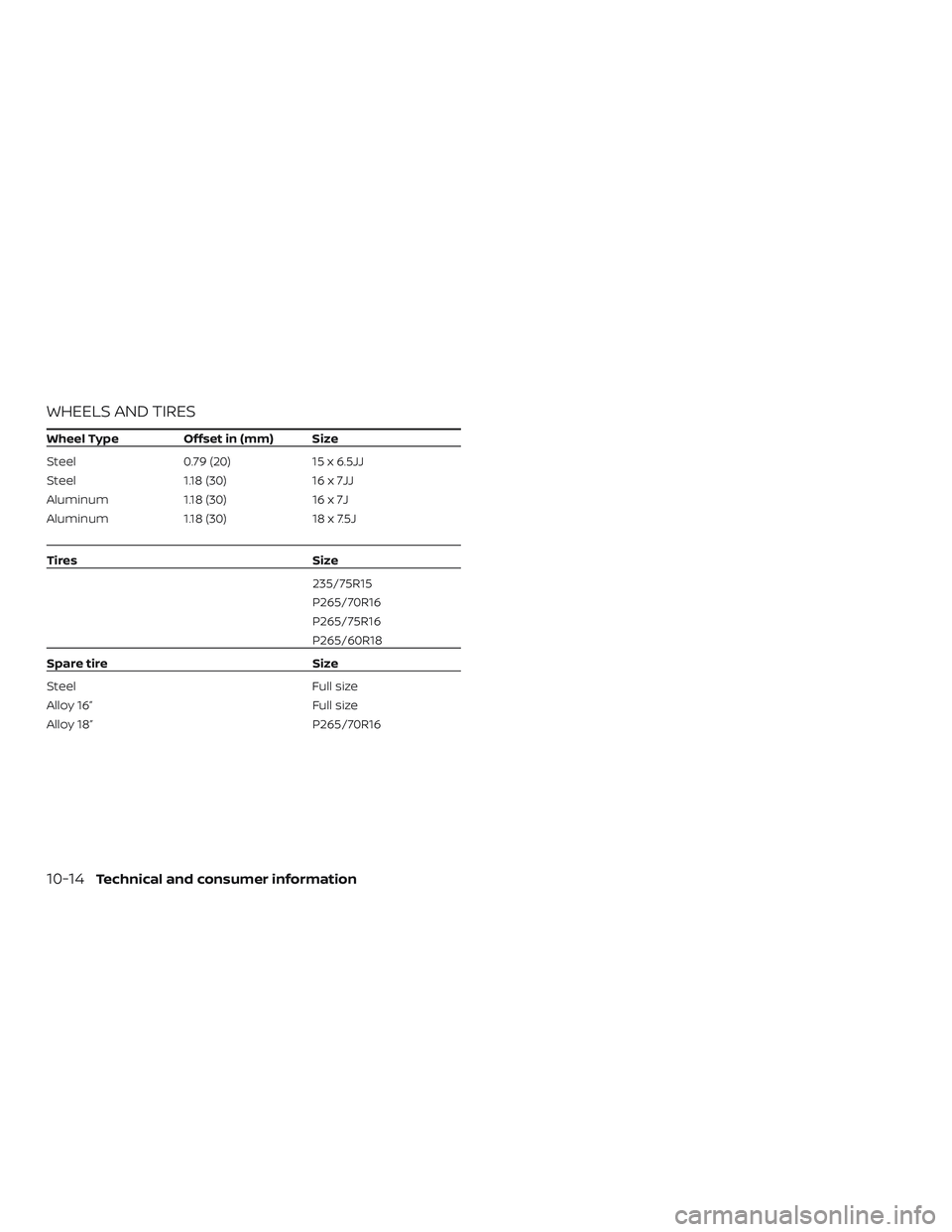
WHEELS AND TIRES
Wheel TypeOffset in (mm) Size
Steel 0.79 (20)15 x 6.5JJ
Steel 1.18 (30)16 x 7JJ
Aluminum 1.18 (30)16 x 7J
Aluminum 1.18 (30)18 x 7.5J
Tires Size
235/75R15
P265/70R16
P265/75R16
P265/60R18
Spare tire Size
Steel Full size
Alloy 16” Full size
Alloy 18” P265/70R16
10-14Technical and consumer information
Page 454 of 502
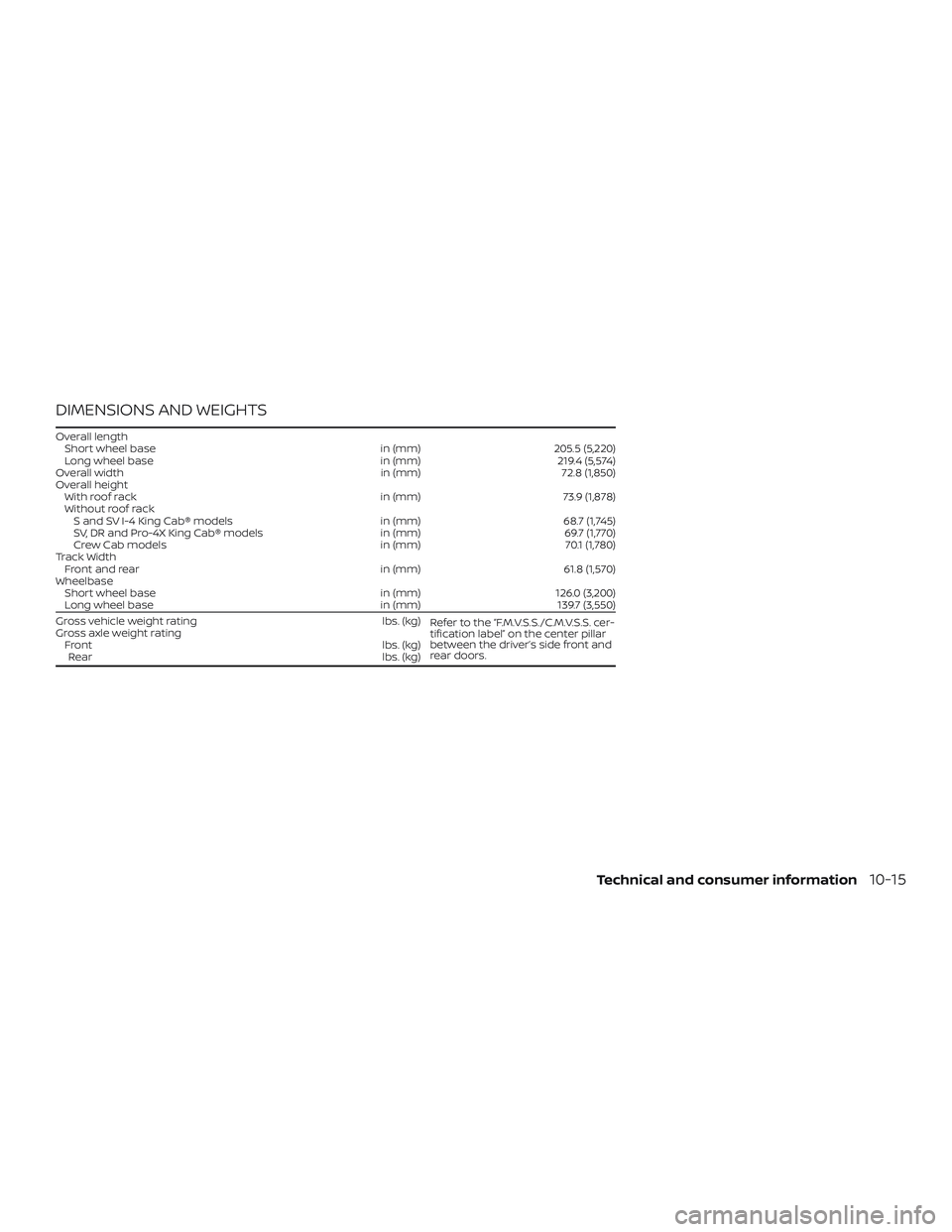
DIMENSIONS AND WEIGHTS
Overall lengthShort wheel base in (mm)205.5 (5,220)
Long wheel base in (mm)219.4 (5,574)
Overall width in (mm)72.8 (1,850)
Overall height With roof rack in (mm)73.9 (1,878)
Without roof rack S and SV I-4 King Cab® models in (mm)68.7 (1,745)
SV, DR and Pro-4X King Cab® models in (mm)69.7 (1,770)
Crew Cab models in (mm)70.1 (1,780)
Track Width Front and rear in (mm)61.8 (1,570)
Wheelbase Short wheel base in (mm)126.0 (3,200)
Long wheel base in (mm)139.7 (3,550)
Gross vehicle weight rating lbs. (kg)
Refer to the “F.M.V.S.S./C.M.V.S.S. cer-
tification label” on the center pillar
between the driver’s side front and
rear doors.
Gross axle weight rating
Front lbs. (kg)
Rear lbs. (kg)
Technical and consumer information10-15
Page 455 of 502
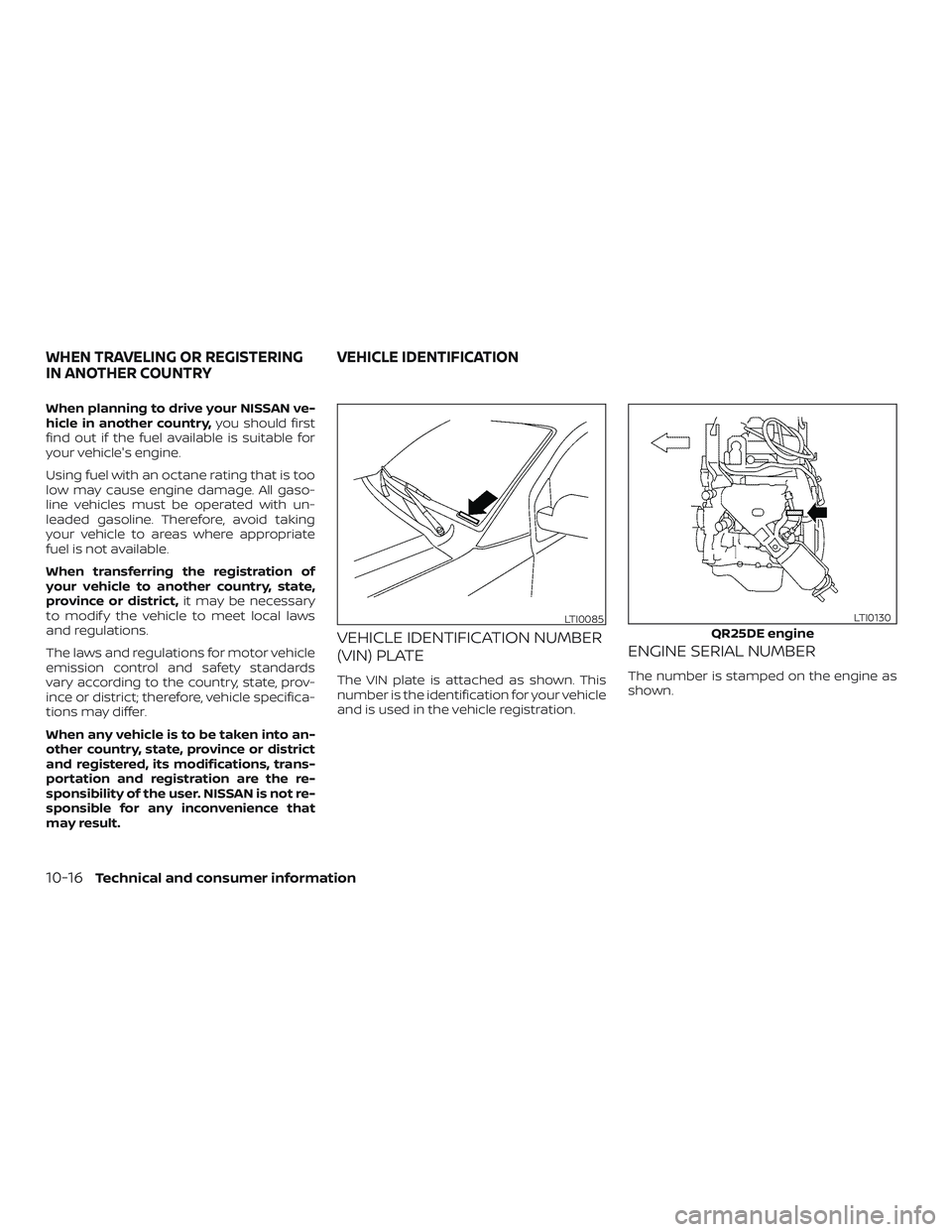
When planning to drive your NISSAN ve-
hicle in another country,you should first
find out if the fuel available is suitable for
your vehicle's engine.
Using fuel with an octane rating that is too
low may cause engine damage. All gaso-
line vehicles must be operated with un-
leaded gasoline. Therefore, avoid taking
your vehicle to areas where appropriate
fuel is not available.
When transferring the registration of
your vehicle to another country, state,
province or district, it may be necessary
to modif y the vehicle to meet local laws
and regulations.
The laws and regulations for motor vehicle
emission control and safety standards
vary according to the country, state, prov-
ince or district; therefore, vehicle specifica-
tions may differ.
When any vehicle is to be taken into an-
other country, state, province or district
and registered, its modifications, trans-
portation and registration are the re-
sponsibility of the user. NISSAN is not re-
sponsible for any inconvenience that
may result.
VEHICLE IDENTIFICATION NUMBER
(VIN) PLATE
The VIN plate is attached as shown. This
number is the identification for your vehicle
and is used in the vehicle registration.
ENGINE SERIAL NUMBER
The number is stamped on the engine as
shown.
LTI0085QR25DE engine
LTI0130
WHEN TRAVELING OR REGISTERING
IN ANOTHER COUNTRY VEHICLE IDENTIFICATION
10-16Technical and consumer information
Page 456 of 502
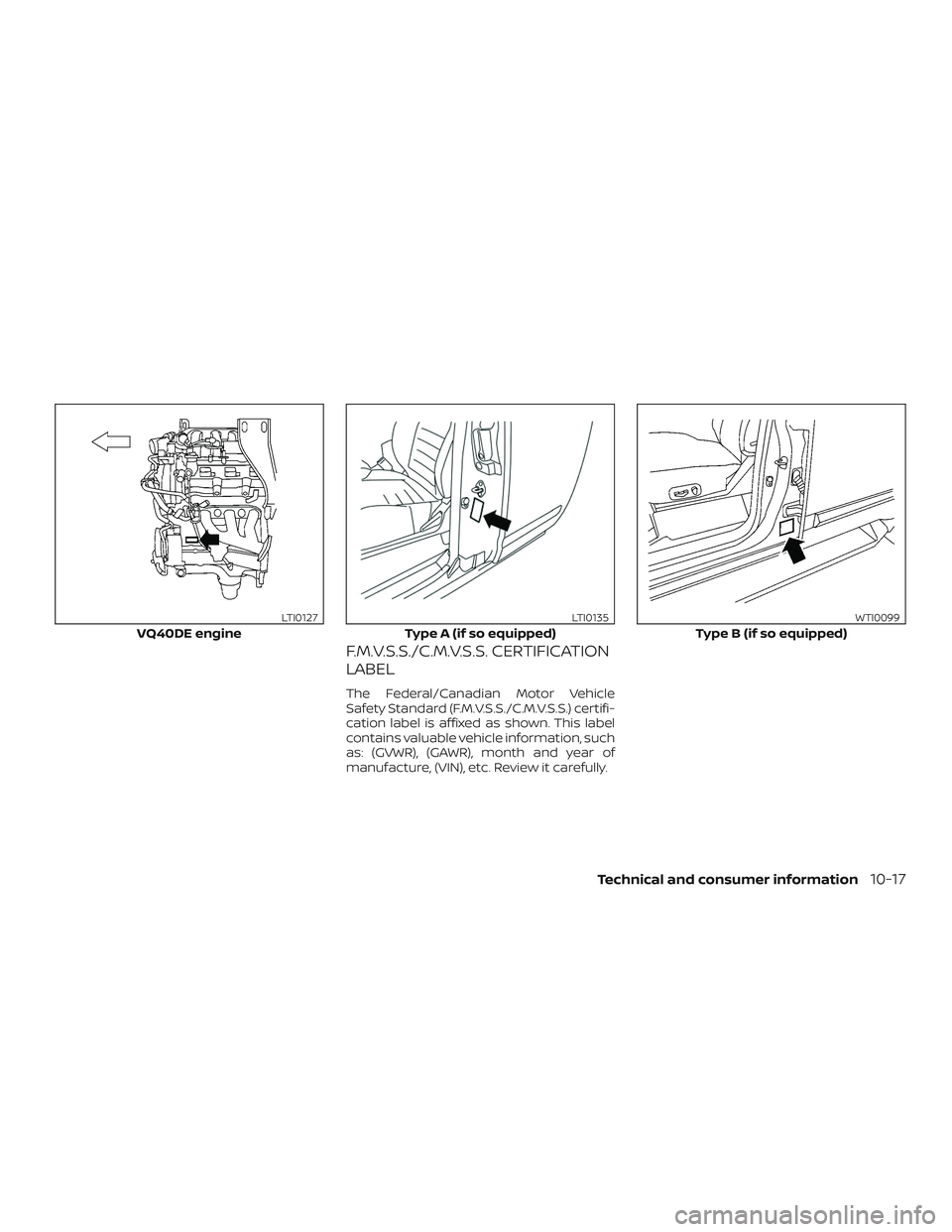
F.M.V.S.S./C.M.V.S.S. CERTIFICATION
LABEL
The Federal/Canadian Motor Vehicle
Safety Standard (F.M.V.S.S./C.M.V.S.S.) certifi-
cation label is affixed as shown. This label
contains valuable vehicle information, such
as: (GVWR), (GAWR), month and year of
manufacture, (VIN), etc. Review it carefully.
VQ40DE engine
LTI0127
Type A (if so equipped)
LTI0135
Type B (if so equipped)
WTI0099
Technical and consumer information10-17
Page 457 of 502
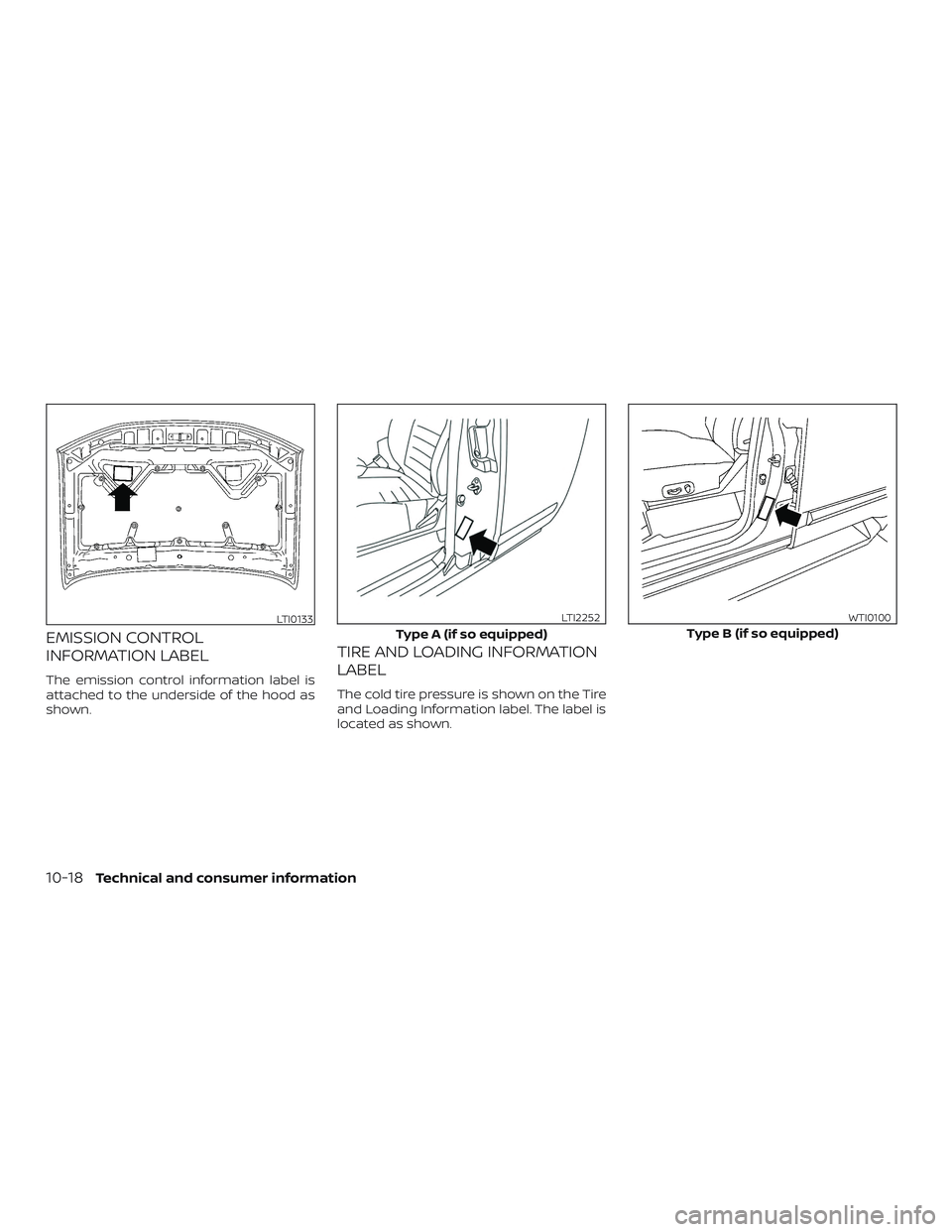
EMISSION CONTROL
INFORMATION LABEL
The emission control information label is
attached to the underside of the hood as
shown.
TIRE AND LOADING INFORMATION
LABEL
The cold tire pressure is shown on the Tire
and Loading Information label. The label is
located as shown.
LTI0133
Type A (if so equipped)
LTI2252
Type B (if so equipped)
WTI0100
10-18Technical and consumer information
Page 458 of 502
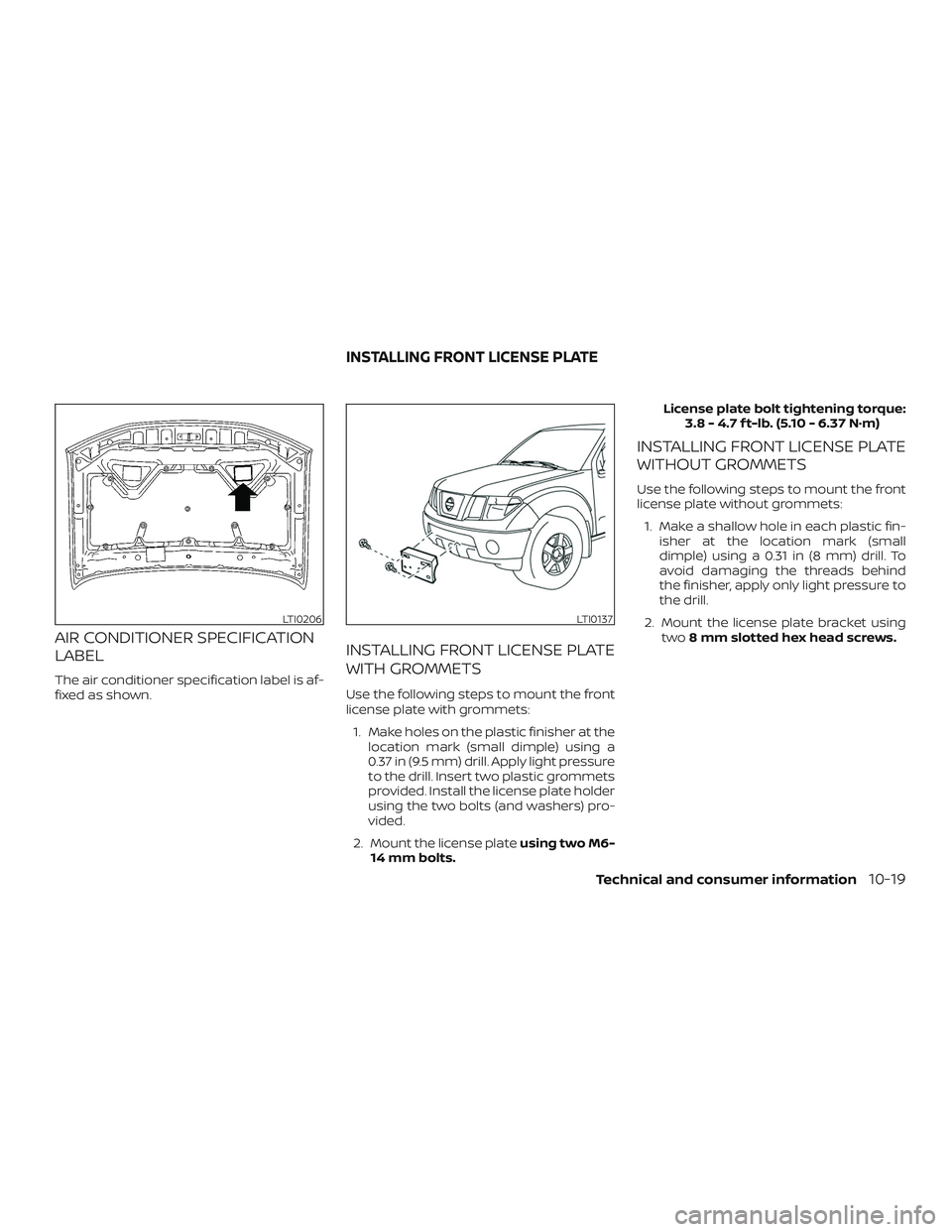
AIR CONDITIONER SPECIFICATION
LABEL
The air conditioner specification label is af-
fixed as shown.
INSTALLING FRONT LICENSE PLATE
WITH GROMMETS
Use the following steps to mount the front
license plate with grommets:1. Make holes on the plastic finisher at the location mark (small dimple) using a
0.37 in (9.5 mm) drill. Apply light pressure
to the drill. Insert two plastic grommets
provided. Install the license plate holder
using the two bolts (and washers) pro-
vided.
2. Mount the license plate using two M6-
14 mm bolts. License plate bolt tightening torque:
3.8 - 4.7 f t-lb. (5.10 - 6.37 N·m)
INSTALLING FRONT LICENSE PLATE
WITHOUT GROMMETS
Use the following steps to mount the front
license plate without grommets:
1. Make a shallow hole in each plastic fin- isher at the location mark (small
dimple) using a 0.31 in (8 mm) drill. To
avoid damaging the threads behind
the finisher, apply only light pressure to
the drill.
2. Mount the license plate bracket using two 8 mm slotted hex head screws.
LTI0206LTI0137
INSTALLING FRONT LICENSE PLATE
Technical and consumer information10-19
Page 459 of 502
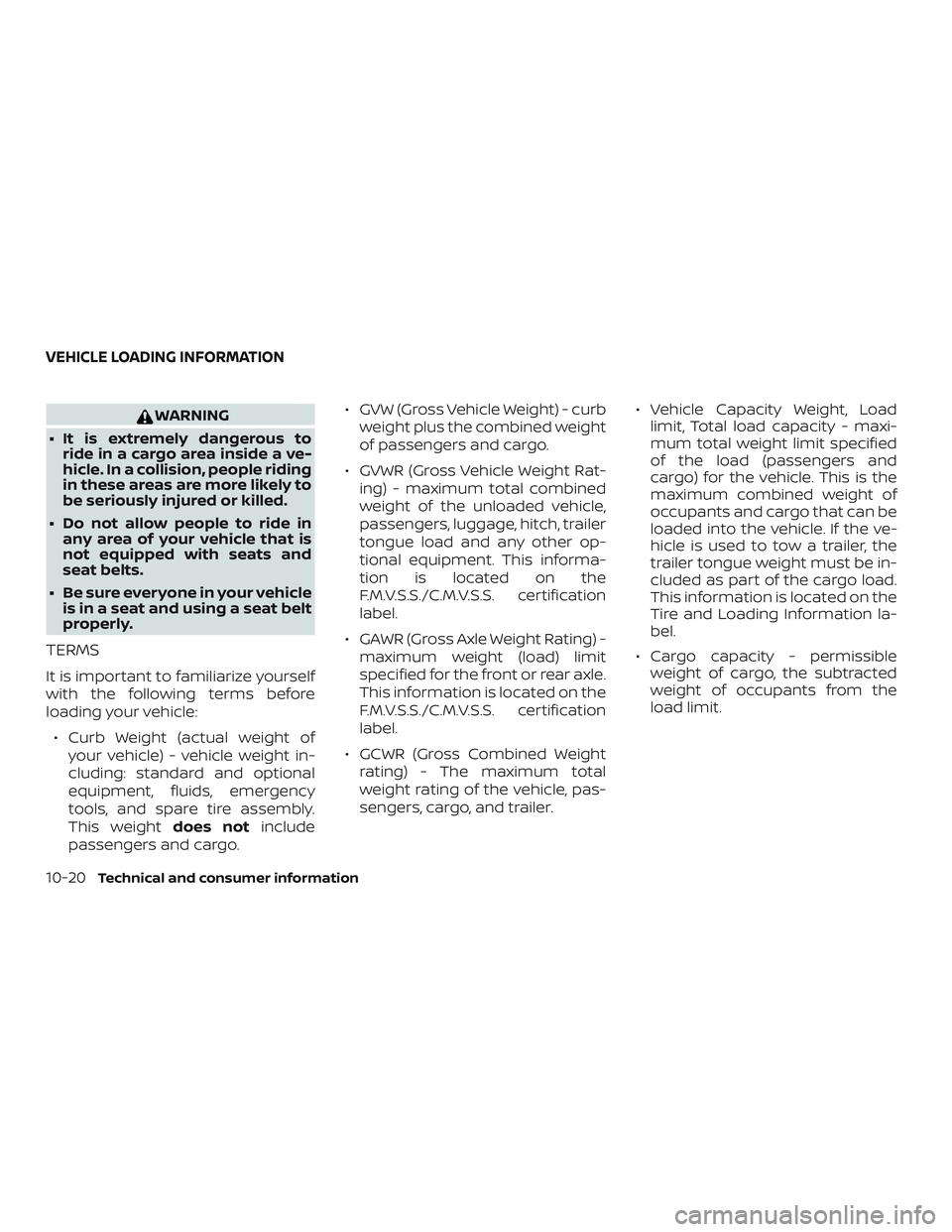
WARNING
∙ It is extremely dangerous to ride in a cargo area inside a ve-
hicle. In a collision, people riding
in these areas are more likely to
be seriously injured or killed.
∙ Do not allow people to ride in any area of your vehicle that is
not equipped with seats and
seat belts.
∙ Be sure everyone in your vehicle is in a seat and using a seat belt
properly.
TERMS
It is important to familiarize yourself
with the following terms before
loading your vehicle:
∙ Curb Weight (actual weight of your vehicle) - vehicle weight in-
cluding: standard and optional
equipment, fluids, emergency
tools, and spare tire assembly.
This weight does notinclude
passengers and cargo. ∙ GVW (Gross Vehicle Weight) - curb
weight plus the combined weight
of passengers and cargo.
∙ GVWR (Gross Vehicle Weight Rat- ing) - maximum total combined
weight of the unloaded vehicle,
passengers, luggage, hitch, trailer
tongue load and any other op-
tional equipment. This informa-
tion is located on the
F.M.V.S.S./C.M.V.S.S. certification
label.
∙ GAWR (Gross Axle Weight Rating) - maximum weight (load) limit
specified for the front or rear axle.
This information is located on the
F.M.V.S.S./C.M.V.S.S. certification
label.
∙ GCWR (Gross Combined Weight rating) - The maximum total
weight rating of the vehicle, pas-
sengers, cargo, and trailer. ∙ Vehicle Capacity Weight, Load
limit, Total load capacity - maxi-
mum total weight limit specified
of the load (passengers and
cargo) for the vehicle. This is the
maximum combined weight of
occupants and cargo that can be
loaded into the vehicle. If the ve-
hicle is used to tow a trailer, the
trailer tongue weight must be in-
cluded as part of the cargo load.
This information is located on the
Tire and Loading Information la-
bel.
∙ Cargo capacity - permissible weight of cargo, the subtracted
weight of occupants from the
load limit.
VEHICLE LOADING INFORMATION
10-20Technical and consumer information
Page 460 of 502
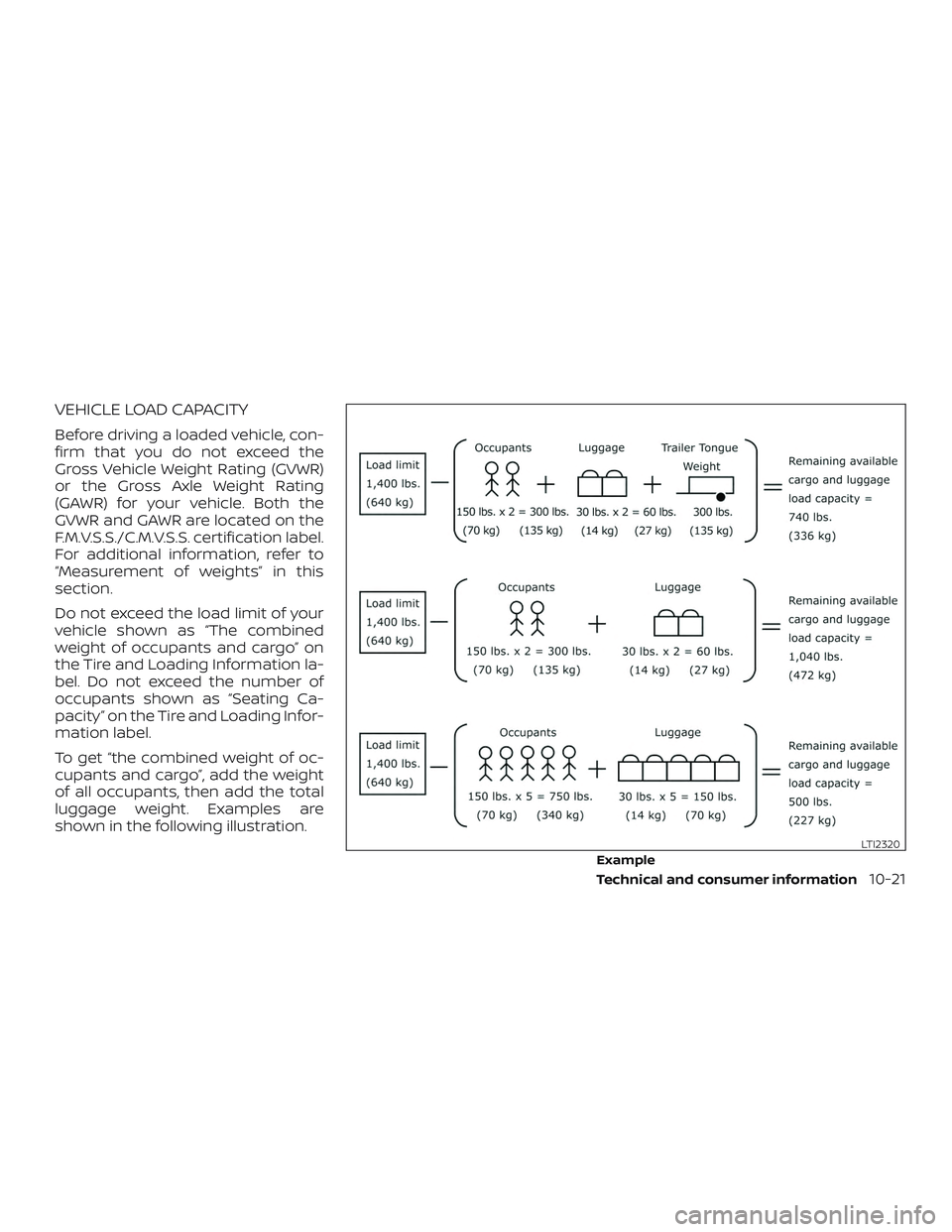
VEHICLE LOAD CAPACITY
Before driving a loaded vehicle, con-
firm that you do not exceed the
Gross Vehicle Weight Rating (GVWR)
or the Gross Axle Weight Rating
(GAWR) for your vehicle. Both the
GVWR and GAWR are located on the
F.M.V.S.S./C.M.V.S.S. certification label.
For additional information, refer to
“Measurement of weights” in this
section.
Do not exceed the load limit of your
vehicle shown as “The combined
weight of occupants and cargo” on
the Tire and Loading Information la-
bel. Do not exceed the number of
occupants shown as “Seating Ca-
pacity” on the Tire and Loading Infor-
mation label.
To get “the combined weight of oc-
cupants and cargo”, add the weight
of all occupants, then add the total
luggage weight. Examples are
shown in the following illustration.
Example
LTI2320
Technical and consumer information10-21